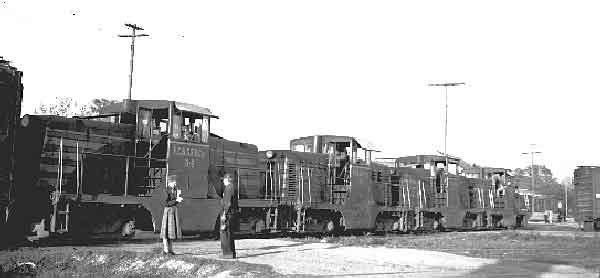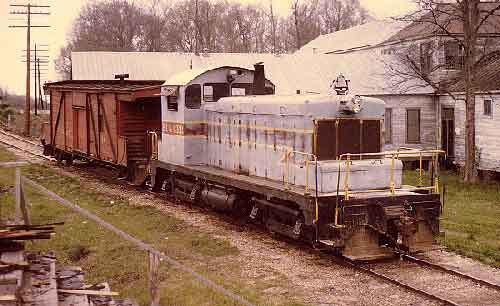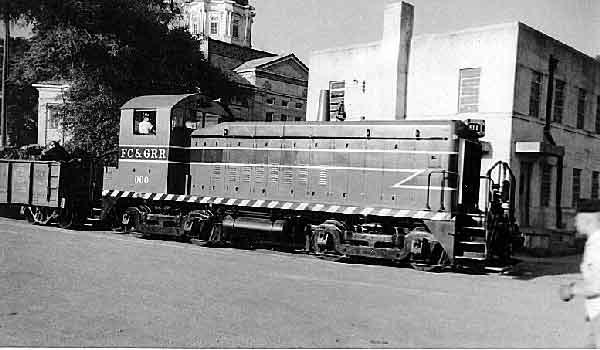Tap Lines
SHORTLINE, NARROW GAUGE
AND INDUSTRIAL
RAILROAD
PHOTOGRAPHS AND HISTORY
August of
1998
Page
Two
Number 26
All text and
images
in Taplines are copyrighted 1998 and and any Commercial use is
reserved
and must be
cleared by written permission by Donald R. Hensley, Jr. and the
indivdual
authors and/or photographers.
THE FERNWOOD, COLUMBIA & GULF RAIL ROAD
Part Two
A COLORFUL MISSISSIPPI
SHORT
LINE
by
David S.
Price
For more info
see the Logging Railroads of Mississippi web site
Photos from authors collection.

Four GE 44 ton locomotives coupled together
for multiple unit operation on the FC&G daily freight.
Locomotives
from right to left are D-1, D-4, D-5, and D-2. Fernwood,
Mississippi.
March, 1956.
Photo by William H. B. Jones. Original
negative
in the David S. Price collection.
Dieselization came
early to the
FC&G.
In Spring, 1945 the railroad purchased three
new 44 ton diesel-electrics from General Electric and numbered them
D-1, D-2, and D-
3. These were followed in April 1947 by another new GE
44-tonner
Number D-4. In
1950 a fifth 44-tonner was purchased used. This unit had been
New York, Ontario &
Western #103. It became FC&G D-5. The fleet of
44-tonners
was completed with the
purchase of another used unit from the Mississippi Export.
This locomotive had also
been a former NYO&W unit and was numbered D-6 by the
FC&G.
The former NYO&W
engines were both built in 1941 making D-5 and D-6 the oldest GE's
on the roster.
These 44 ton machines proved too light for satisfactory service
on the FC&G. Iddo
Enochs recalls a variety of maintenance problems with them stemming
from the heavy
demands of service. The FC&G as an East-West carrier
crossed
many water courses
which run generally North to South in southern Mississippi.
The line traversed rolling
hills making for several short, but demanding, grades on
right-of-way
built originally for
log trains. This taxed light locomotives to the maximum.
The GE's were set-up for
multiple unit operation, and it was not unusual to see four of the
little GE diesels
struggling to move tonnage over the line. The multiple unit
operation of four little
diesels presented an unusual sight.

FC&G SW-1 #600 coupled to caboose behind the
company
offices at Fernwood, Mississippi.
Old depot which was being
dismantled
provided the vantage point for this Kodachrome taken by David S. Price
in 1968.
The six small GE's were
replaced by two larger EMD's which
became the total
motive power for the FC&G's remaining years of operation.
Both EMD locomotives
carried road numbers equal to their rated horsepower. EMD
SW-1 Number 600 was
the smaller of the two and was favored as the regular switch engine
at Fernwood. This
locomotive was usually found making up the daily train for
locomotive
Number 900, an
EMD SW-900, which had been purchased new in 1957. When tonnage
reached about
fifteen cars or so, Number 600 would couple behind the caboose at
Fernwood and
serve as a pusher to assist Number 900 with the train. After
crossing the Bogue Chitto
River and topping the stiff hill just east of the bridge, Number
600 would uncouple on
the fly and return light to Fernwood to finish switching chores
there. Number 900 could
handle the train over the remainder of the line. Returning
from Foxworth the line
ascended for most of the nine and one-half miles to Kokomo.
When Number 600
handled the main line run the engineer could keep the throttle wide
open over this
portion of the line and literally count the cross ties as they
slowly
disappeared under the
pilot of the engine.

Engineer V. W. Barr handles the throttle of diesel
#900 in April, 1957.
The Marion County courthouse is visible
behind
the locomotive in this view taken by William H. B. Jones at Columbia,
Mississippi.
Original negative in the collection of David S. Price
The cover photograph South
Illustrated magazine in March
1964
featured a color
photograph of Iddo Enochs, president of the FC&G. Inside
was a seven page, photo-
filled article "No Room For Red Ink" focusing on the Enochs family's
B&HS and FC&G
railroads and their profitability. "Both railroads serve rural
Southern Mississippi, the
Fernwood, Columbia & Gulf providing service along its 44 mile
run...with at least a third
of its revenue load derived from "bridge" tonnage originating and
terminating beyond
FC&G terminals." The irony of this statement is that
within
a few years all this bridge
tonnage between the Illinois Central at Fernwood and Gulf, Mobile
& Ohio at Tylertown
and Foxworth would be threatened by the merger of these two roads
into one system,
the Illinois Central Gulf. This caused President Enochs to
petition for both the FC&G
and B&HS to be included in the merger. On September 1,
1972, the FC&G became
part of the newly formed Illinois Central Gulf. Enochs'
B&HS
had enjoyed lucrative
bridge traffic involving the IC, GM&O and Mississippi Central,
all three of which would
become parts of the newly formed ICG. Thus in 1972 the Enochs
family found
themselves out of the railroad business for the first time in almost
ninety years,
counting logging days before the F&G was incorporated.
The Illinois Central Gulf made
short work of abandoning
the
FC&G. The B&HS,
however, became an increasingly important link in the
Jackson-Hattiesburg-Beaumont-
Mobile line and in time received a complete rebuilding with heavier,
welded rail. For a
time the ICG stored cars on the disused main line of the old
FC&G.
Soon the tracks
were removed and the right of way allowed to return to nature.
Today only those who
know where to look and are willing to search very hard are able
to ascertain the
location of the old roadbed.
The FC&G was in reality a
very typical and
not-too-significant
shortline by
nationwide railroad standards. Yet for many years it provided
needed and more-or-less
efficient transportation necessary for economic development in a
rural area. It was for
those who remember a colorful and delightful little carrier.
What a treat it was to ride
the cab or caboose on the daily freight, or to witness from track
side the pusher
engine uncoupling as speed increased at the top of the ruling
grade.
In latter years of
operation one could count on seeing well maintained locomotives
and caboose and
light iron well aligned and in good repair snaking over undulating
grades and through
colorful, red clay cuts through the hills. There were few
places prettier than the quiet
depot and freight house at Kokomo on a spring evening in the rosy
light of a setting
Mississippi sun.


